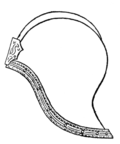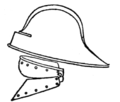end of the fifteenth century, which is one of the few remaining, and is delicately forged in one piece of thin, hard steel.
During the fourteenth century a new kind of helmet arose, called in England the "sallad," or "sallet." The word appears to have two derivations, each of which was applied to a different form of head-piece. First, the Italian "celata" (Fig. 594), which seems originally to have been a modification of the bascinet. Second, the German "schallern," the form of which was probably suggested by the chapelle-de-fer. Both of these were called by the French "salade," whence our English "sallad." The celata came lower down than the bascinet, protected the back and sides of the neck, and, closing round the cheeks, often left only the eyes, nose, and mouth exposed. A standard of mail protected the neck if required. In the fifteenth century the celata ceased to be pointed at the summit, and was curved outwards at the nape of the neck, as in Fig. 595.
The "schallern" (from shale, a shell, or bowl), was really a helmet and visor in one piece; it had a slit for the eyes, a projecting brim, and a long tail, and was completed by a chin-piece, or "bavier" (Eng. "beaver"), which was strapped round the neck. Fig. 596 shows a German sallad and a Spanish beaver. The sallad was much used in the fifteenth century, during the latter half of which it often had a visor, as in one from Rhodes (Fig. 597), which has a spring catch on the right side to hold the visor in place when down. The rivets for its lining-cap have large, hollow, twisted heads, which are seldom found on existing sallads, though often seen in sculpture.
 Fig. 594. |
 Fig. 595. |
 Fig. 596. |
 Fig. 597. |
The schale, schallern (schêlern), or sallad, either with or without a

